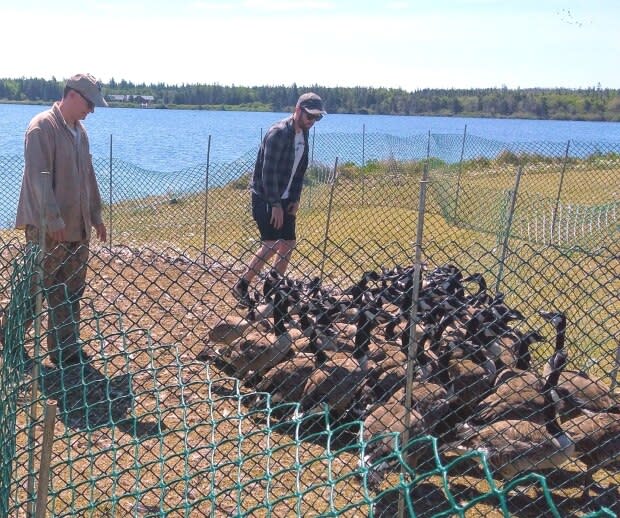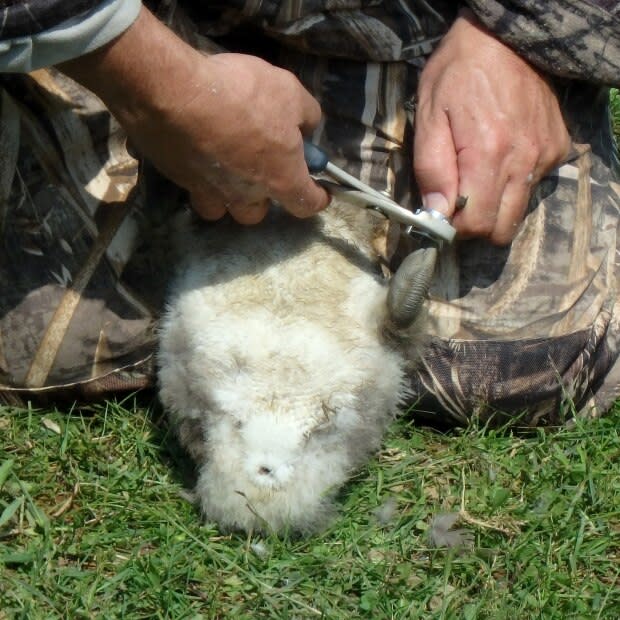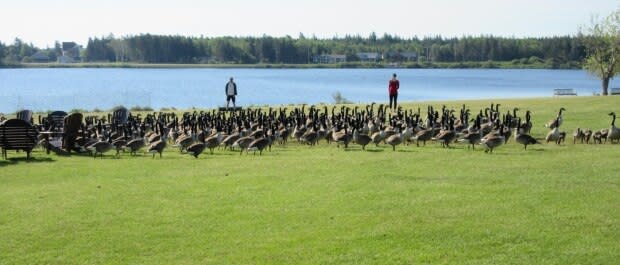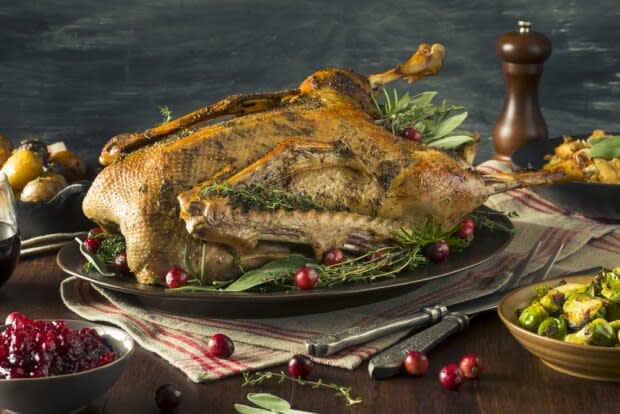Why Canada geese love to visit Dalvay
Anyone who has visited Dalvay By The Sea in June and July has seen them. Canada geese — hundreds of them, year after year, honking and waddling around like they own the place.
But they don't come for the antique-filled guest rooms, large wood-burning fireplace or fine dinner cuisine.
They come for the lush lawn and large, easily accessible lake.
That's because during those summer months, they moult their feathers, meaning they can't fly for up to 35 days, said Al Hanson, head of the Aquatic Assessment Unit for the Canadian Wildlife Service.
"During that time period they're looking for two main things," he said.
Dalvay is, to our knowledge, the most important moulting site for Canada geese in Prince Edward Island. — Al Hanson, Canadian Wildlife Service
"One is a safe haven from predators, which a large body of water provides them. And the other thing they're looking for is a food source that's high in protein so they can regrow their feathers, and the manicured lawns in and around Dalvay afford them that opportunity as well."
It also affords the Canadian Wildlife Service the opportunity to corral and band the geese, which Hanson said they've been doing in collaboration with Parks Canada for the past two summers to better understand their population dynamics.

In 2018, they captured and banded 292 Canada geese at Dalvay, Hanson said. This year they captured about 400 — 200 of which they had previously banded at Dalvay and other locations throughout P.E.I.
"The same birds seem to be going back year after year," he said, noting they usually leave the area around August.
"Dalvay is, to our knowledge, the most important moulting site for Canada geese in Prince Edward Island. It plays a very important role in the annual cycle of P.E.I.'s giant Canada geese population."
Here are some other interesting facts about Canada geese on P.E.I.
They are faithful partners

It might take them two or three years to start breeding, but once they find a mate, they became partners for life, which can be about 25 years. That's unlike some duck species, which get sick of each other and form new pair bonds each year.
"Canada geese are monogamous," Hanson said. "Adults will live their entire lives together and return to the same area year after year to breed."
They share the parenting

Unlike other birds, who moult their feathers one at a time and never lose the ability to fly, Canada geese go all or nothing. This happens, conveniently, after the breeding season when their young also happen to be flightless, Hanson said.
They share the parenting while they're all on the ground.
"Both the male and the female look after the young and because of that you'll have a family group," Hanson said.
"They establish a nest, they hatch the eggs, they raise the nestlings to flight and then they'll travel together as a family group throughout the winter."
Their population has grown drastically

Giant Canada geese, the largest of the seven subspecies of Canada geese and the ones you see at Dalvay, were thought to be extinct by the 1950s but a flock of 200 were rediscovered in 1962 in Minnesota.
Due to some purposeful early reintroduction programs and ideal habitat created by humans, the population has drastically increased since then, Hanson said, with population estimates of more than one million in the Atlantic flyway and two million in the Mississippi flyway.
"They have been on P.E.I. for the last 20 years or so," he said.
They don't all migrate south

They can be seen as far away as Florida in the winter months, but depending on the conditions, some stick around the Maritimes all year long, Hanson said.
"Some of our birds in New Brunswick, Nova Scotia, Prince Edward Island may just migrate a couple hundred kilometres, if that, to coastal areas where they have open water during the winter months and an opportunity for feeding."
They are 'very tasty'

The expression "cook your goose" may sound ominous, but don't let that fool you.
"They're very tasty," Hanson said. "They're large bodied birds and the fact that they've been eating grass means they're very mild flavoured. The breast meat is very similar to a steak."
You might get an opportunity to try it — the hunting season for giant Canada geese on P.E.I. is Sept. 3-16.
Not everyone likes them

They can be an obstacle for aircraft and can also become very aggressive and launch attacks against anyone they consider a threat to their nests.
And if you see them nearby, watch your step — especially if you're wearing new shoes.
Because they are herbivorous and eat a lot of plant material, Canada geese tend to produce more droppings than some species of ducks, Hanson said. They also spend a lot of time on land so their droppings are more evident.
"In some areas of the country people find that their excessive droppings on the ground is a nuisance, and for some farmers they can be a nuisance when they get into winter wheat and other crops early in the spring," he said.
Will Murphy, a manager at Dalvay By The Sea, said staff have to rake the droppings and pick up feathers daily, but he doesn't consider the geese much of a problem because the guests enjoy their company.
"Just sitting there in the dining room having dinner and seeing over 200 geese out on the grass is a pretty marvellous scene," he said.
"They are certainly an attraction here."
More P.E.I. news


